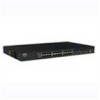Dell PowerConnect 5324 User's Guide Addendum - Page 15
Enabling SNMP Notifications, Enabling Authentication Notifications
 |
View all Dell PowerConnect 5324 manuals
Add to My Manuals
Save this manual to your list of manuals |
Page 15 highlights
Local Engine ID (10 - 64 Hex Characters) - Indicates the local device engine ID. The field value is a hexadecimal string. Each byte in hexadecimal character strings is two hexadecimal digits. Each byte can be separated by a period or a colon. The Engine ID must be defined before SNMPv3 is enabled. For stand-alone devices select a default Engine ID that is comprised of Enterprise number and the default MAC address. Use Default - Uses the device generated Engine ID. The default Engine ID is based on the device MAC address and is defined per standard as: First 4 octets - first bit = 1, the rest is IANA Enterprise number. Fifth octet - Set to 3 to indicate the MAC address that follows. Last 6 octets - MAC address of the device. SNMP Notifications - Enables or disables the router sending SNMP notifications. Authentication Notifications - Enables or disables the router sending SNMP traps when authentication fails. Enabling SNMP Notifications 1 Open the SNMP Global Parameters page. 2 Select Enable in the SNMP Notifications field. 3 Click Apply Changes. SNMP notifications are enabled, and the device is updated. Enabling Authentication Notifications 1 Open the SNMP Global Parameters page. 2 Select Enable in the Authentication Notifications field. 3 Click Apply Changes. Enabling SNMP Notifications Using CLI Commands The following table summarizes the equivalent CLI commands for viewing fields displayed in the SNMP Global Parameters page. Table 1-5. SNMP Notification Commands CLI Command snmp-server enable traps snmp-server trap authentication show snmp Description Enables the router to send Simple Network Management Protocol traps. Enables the router to send Simple Network Management Protocol traps when authentication fails. Checks the status of SNMP communications. 15















